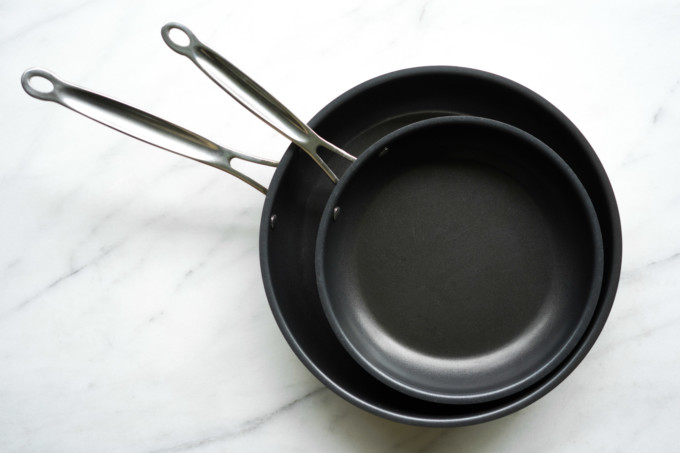
Your trusty omelette pan starts showing some age. Let’s face it, you’ve been needing to replace it for a long time now. You’ve seen new pan technologies pop up and wanted to dedicate some time to shop around and “do some research.”
Boy oh boy. There’s a lot to know, and maybe not so much you need to know. We’ll try to cover the basics. First of all…
What is PFOA and what does it have to do with cookware?
PFOA stands for “perfluorooctanoic acid.” It is most associated with Teflon, even though it is not found in Teflon. Not in, but around. It’s used to make Teflon, and other such water-resistant things, but PFOA is burned off in the process.
Other things that are also made with PFOA: stain-resistant carpet, water-repellent clothes, paper/cardboard packaging, ski wax, fire-fighting foam, sealants, floor wax. PFOAs can be created when other chemicals (like fluorotelomers) break down.
So if it’s not IN Teflon, then why do we care? Well, PFOA has only gained notoriety in recent years because of its shocking discovery everywhere–no exaggeration. It’s found in every continent, in our drinking water and in our bodies. Because it doesn’t dissolve in water or in the ground (which is precisely why it’s so useful), it stays out there and can travel for miles eventually making its way to the ocean where it sits on the surface.
So while the American Cancer Society confidently states that “non-stick cookware is not a significant source of PFOA exposure,” the manufacturing of Teflon has contributed to the world’s contamination of this forever chemical. It wasn’t just Teflon, PFOAs have been used in industrial quantities in many facets of our lives since the 1940s.
PFOA health effects
Now the scary part. We all have PFOAs inside us already. Our blood serum levels range from 2 to 8 parts per billion. In 2016, the EPA announced a “lifetime health advisory,” reporting that high levels of exposure may cause:
- Testicular and kidney cancer
- Problems to fetuses, breastfed babies, low birth weight, early puberty, immune system problems
- Liver damage
- Thyroid disease
- Ulcerative colitis
- Cholesterol changes
- Blood pressure changes during pregnancy
The sources of PFOA exposure are vaguely listed as: food, drinking water, outdoor air, indoor air, dust, and food packaging. Of those, they have no idea which source poses the greatest risk. Please note the lack of “non-stick cookware” from the list. In a recent study, PFOA levels on non-stick cookware were reported at levels “undetectable (<1.5) to 4.3 parts per billion.”
Some good-ish news
In 2006, the EPA and 8 US manufacturers agreed to a “stewardship program” to end PFOA emissions and contents by the end of 2015. As a result, PFOAs and PFOS are no longer made in the US. However, PFOAs are still made in other countries so it is likely that we are still exposed.
While PFOAs have at least been curtailed in the US, you better believe that there are alternatives with similar characteristics that some fear may be just as bad down the line. The long term effects of these new chemicals are yet unknown. Just as we see a decrease of PFOAs in our blood, a chemical known as PFNA increases in US consumers.
Okay, i said good-ish.
This just in, in early 2020, the EPA announces a “proposed decision” to regulate PFOA and PFOS in drinking water. Even though that sounds a bit vague and maybe non-committal, it seems to be a step in the right direction for US citizens.
What is PFOA-Free nonstick cookware?
When you swallow this rather unsettling information about PFOA, and thoughts of recipes we’ve made here like bánh xèo (Vietnamese sizzling crepes), cá kho tộ (Vietnamese caramelized catfish), or even ingredient prep for bánh giò come wafting back into memory, it’s time to get down to replacing that pan already!
It’s time for PFOA-Free nonstick cookware. We are instantly transported to a simpler time. A time when you hang your heavily-seasoned cast-iron pan back up in that there covered wagon.
Okay, wait. Can I make a French omelette on a cast iron pan? Maybe with a couple sticks of butter, but it would be really difficult to flip with that heavy thing. How about a carbon steel skillet? Better, but still not technically “non-stick.” I’m trying to save my butter and watch my cholesterol.
Ok, let’s rewind, and go back… back to the FUTURE!
Ah yes, technology! All that bad press from Teflon gave way to a new market for advancements in the world of non-stick cookware. We have several new patented technologies promising a PFOA-free supply chain. Here are some of those brands:
Made In Cookware
This company makes a 5-ply non-stick pan that uses a PTFE coating that is made without PFOA and PFAS. You can trust this since they are made in the US and because they carry recommendation by the FDA and US Consumer Safety Commission.
Hold on, what is PTFE? Basically, Teflon is the best known brand of PTFE-based coatings. So yes, Made In uses a Teflon-like coating, but assures that they do not use PFOA in manufacturing. To review, the EPA and American Cancer Society concede that Teflon itself is not a significant source of PFOA.
The main drawback of PTFE is that it does not weather high temperatures well. You should avoid using PTFE non-stick cookware for high temperature cooking, like searing. At worst, the fumes will give you a headache. (Please do not ruin your PTFE pans with high heat around pet birds as it can be fatal to them.)
Xtrema
Xtrema takes ceramic cookware to the “xtreme.” This striking set of cookware is bold and thick, taking on a variety of attractive colors, from black to a friendly millennial pinkish beige. “Low and slow” is their mantra, as in you have to use low temperatures and cook slowly as to avoid shocking the purely ceramic vessels to crack.
This 100% ceramic design is based on the 20,000 year old tradition of ceramics, but shaped into familiar shapes of modern cookware. Perhaps the most sustainable and eco-conscious of cookware sets, Xtrema is a unique take on non-stick that may require you to adjust your cooking style a bit.
GreenPan
Move over Teflon, hello “Thermoloon Minerals.” Greenpan boasts this funnily named technology that is a ceramic material derived from sand and infused with diamonds. It’s heat-resistant up to 450•C, so no blistering or toxic fumes when overheated. Whoa.
ScanPan
Our last brand here hawks something they called “Stratanium+” which they claim won’t blister, peel or scrape, even with metal utensils. That sounds awesome! Unlike PTFE-based non-stick coatings, you can use Scanpan with high heat to brown sear and deglaze. This is not your grandma’s Teflon.
Lower budget PFOA-free nonstick options
The aforementioned pans are seriously impressive, but also seriously kind of expensive. It seems like we get ourselves into some unknown troubles when we as a society seek these conveniences and shortcuts with new fangled chemicals with fates that don’t unfold until it’s too late. A bit dramatic, it certainly feels scary out there.
If we all take a breath and look just a bit into the past, we can find some tools made with simpler materials that never stopped being useful. From experience, my favorite new “old” technology is the carbon steel pan. Professional chefs never stopped using them and they look cool as heck.
They’re non-stick with a caveat. Season it, love it and you too will soon have a glassy non-stick surface with which to glide those omelettes. Not as heavy as cast iron, but still with some heft, this old school technology relies on the seasoning–coats of bonded oil that acts as your own non-stick.









